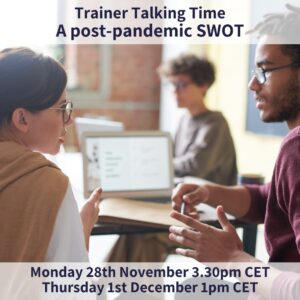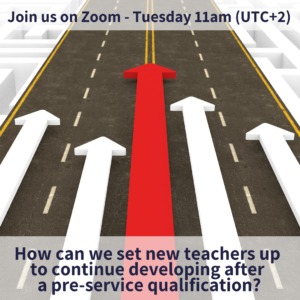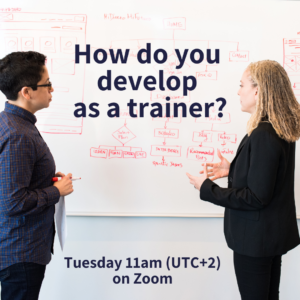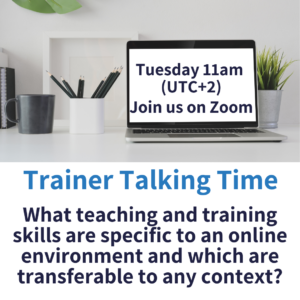Thanks to everyone who attended our return to Trainer Talking Time. You can find all the notes from our previous sessions here. Apologies for the state of the notes here…I’ve just copied them across from a Google Doc we worked on together in the sessions, so they might be a little haphazard!
Our January session is coming up with the question How do you include differentiation for your course participants?
STRENGTHS
Flexibility – opening up to new markets
A wider range of voices/experiences on a course
With online courses, participants have a lot more freedom/flexibility in when they learn
With Trinity moderation costs are now much lower, thanks to it all being done online, so it’s possible to run a course with fewer participants, which perhaps also leads to being able to do more with them – more specialised support, meeting their individual needs more closely.
A lot of trainer knowledge and the coming together of lots of minds with lots of years of experience
Opened our eyes to new ways of training in-house…keeping things online because it suits people’s timetables / doesn’t oblige people to come in when they’re on a part-time contract
Lots of resources available online to share with teachers to support their in-house development – a very rich library
WEAKNESSES
Course participants need extra support to develop strong relationships through online courses
The challenges of connectivity/access to devices for some people makes online training more difficult
A feeling of having less control over what people are doing when they’re working asynchronously…is everything going in?
The quality of observation that can happen through a screen if the lesson is delivered in-person
The need for more plan Bs in online classes
OPPORTUNITIES
Perhaps having more content available online can limit tutor costs (opportunity for the centre, but possible threat for tutors who lose out on contact hours)
Learning through observation
Different ways of giving feedback, giving TP points (e.g. video, images, voice message) – can be more adaptable to a trainee’s needs
More demand for teachers who are able to work legally post-Brexit
Making teachers aware of what routes they can take in teaching, e.g. not working a full-time contract and supplementing a school contract with online classes / private classes….giving them more headspace and time for themselves (a result of the pandemic when we were suddenly forced to stop and realised we didn’t need to go full pelt all the time)
Enabling peer observation through (recording) online lessons
THREATS
Course participants can choose cheaper online options and might be less likely to look for a course based in a particular country where they want to work
There’s a lot of competition! A proliferation of cheaper courses
Teachers gave a lot of themselves during the pandemic and perhaps post-pandemic their workload hasn’t decreased
Feeling the pinch of rising costs
As you can see, the strengths and opportunities seem to outweigh the weaknesses and threats. We also felt that there was often crossover – what was a strength was also an opportunity.
And then there were some other thoughts which didn’t quite seem to fit in any of the four boxes…so here they are!
- Online teaching/training is nothing new to the pandemic
- There are platforms which are for education…but nobody’s willing to try them out yet
- Will people going for pre-service courses go for the cheaper option? Difficult to sell a ‘good’ course to people who haven’t done their research. People with more experience might shop around more, take recommendations from peers, etc.
- Will we see people taking courses but not going into teaching long-term?
- People WANT to take an in-person course rather than online
- Allowing space for learners to chat post-lesson as well, mimicking the corridor experience and allowing for the social connection outside of classtime
- Face to face communication (even if online) more effective / quicker than platforms like Slack. But it provides a good place for regular communication and bits that could easily be forgotten.
- Self-discipline of not being available / having office hours
- Trainers need to be more skilled to deal with blended (synchronous/asynchronous) courses
- Is there a generational difference to how people learn? Do we need ‘trainee training’ at the start of a course?
- Living life in the moment – post-pandemic lots of people wanted to travel, live elsewhere
- Are there still good career development opportunities for folks who take higher level qualifications?





